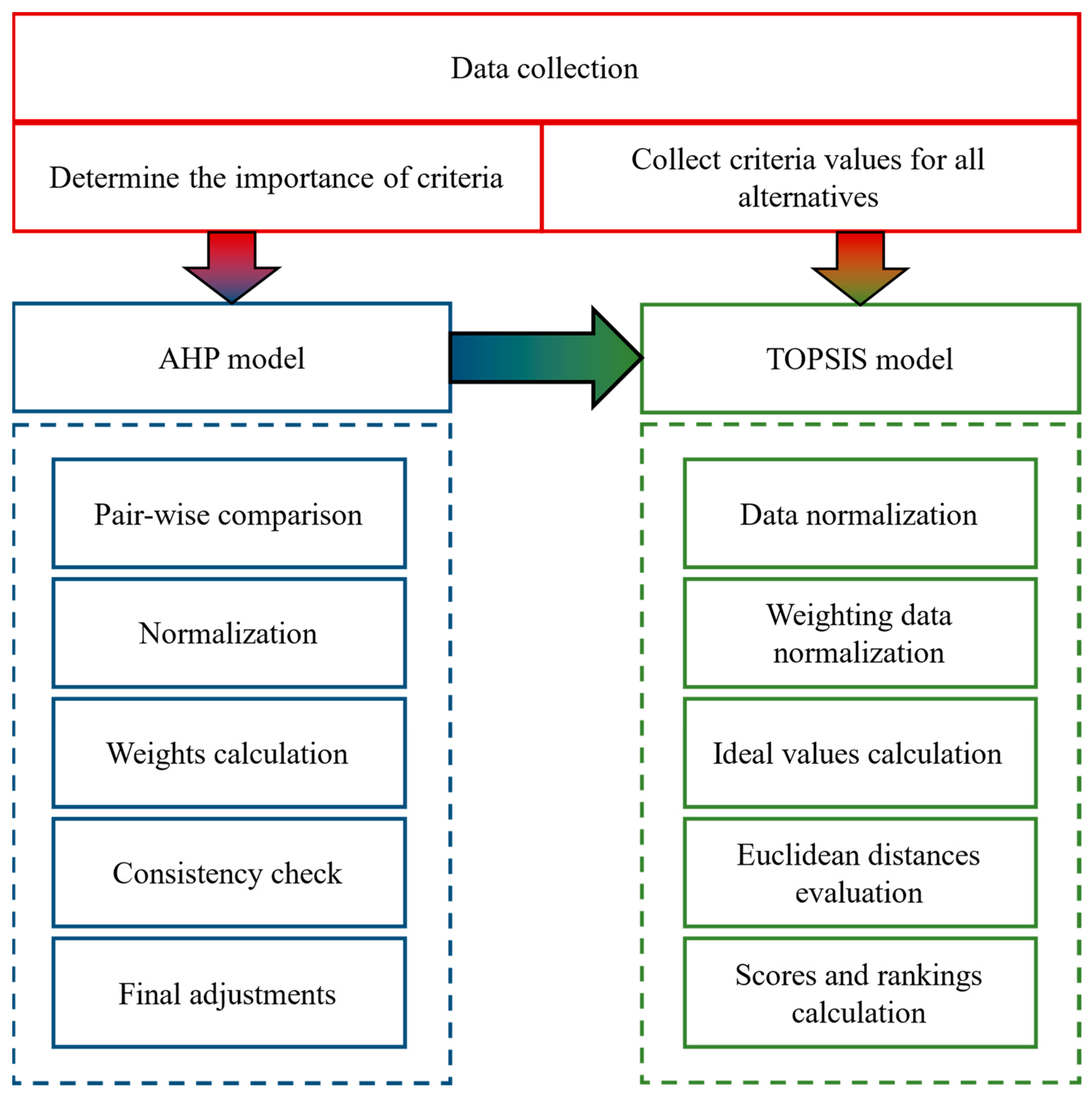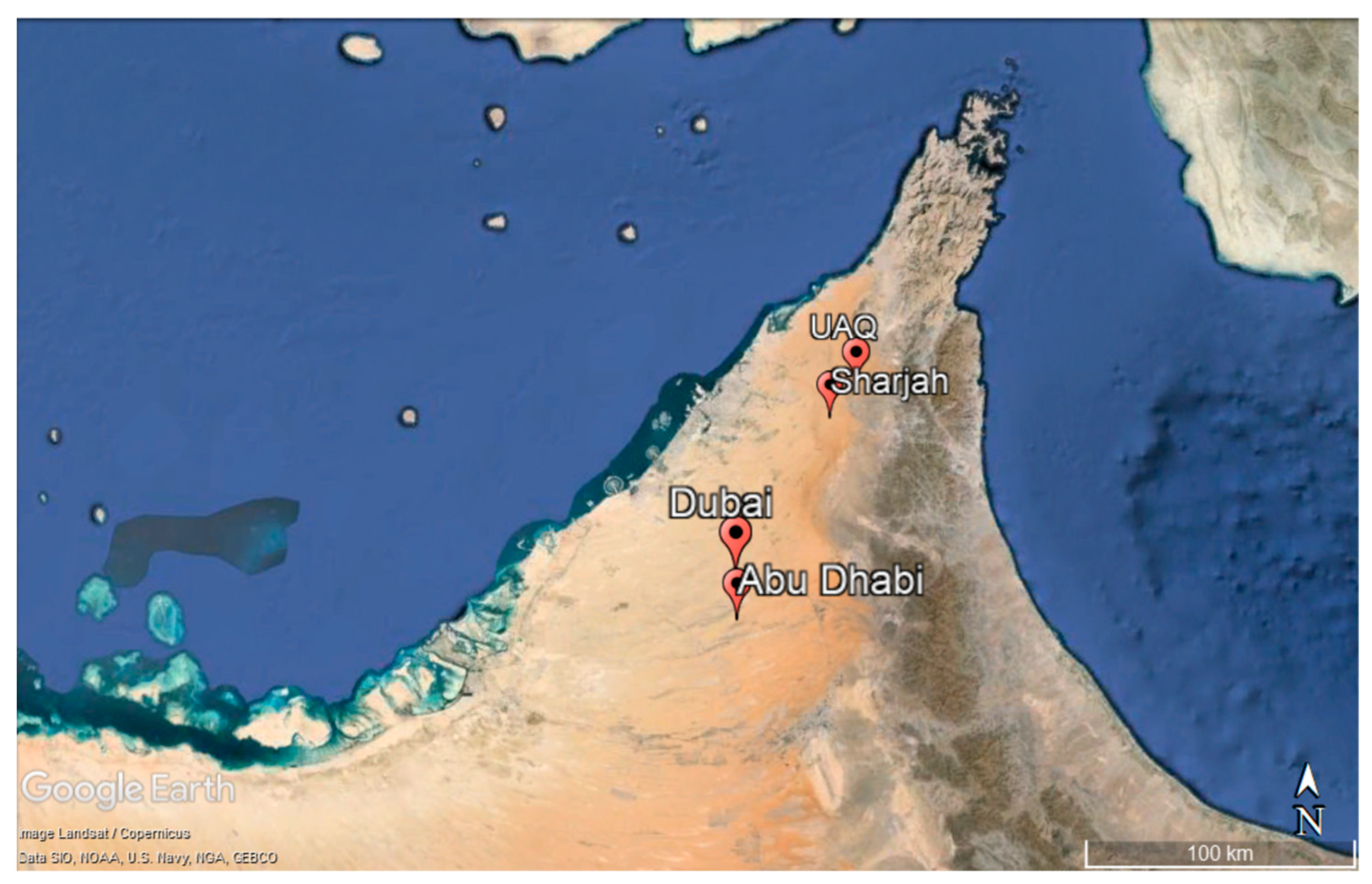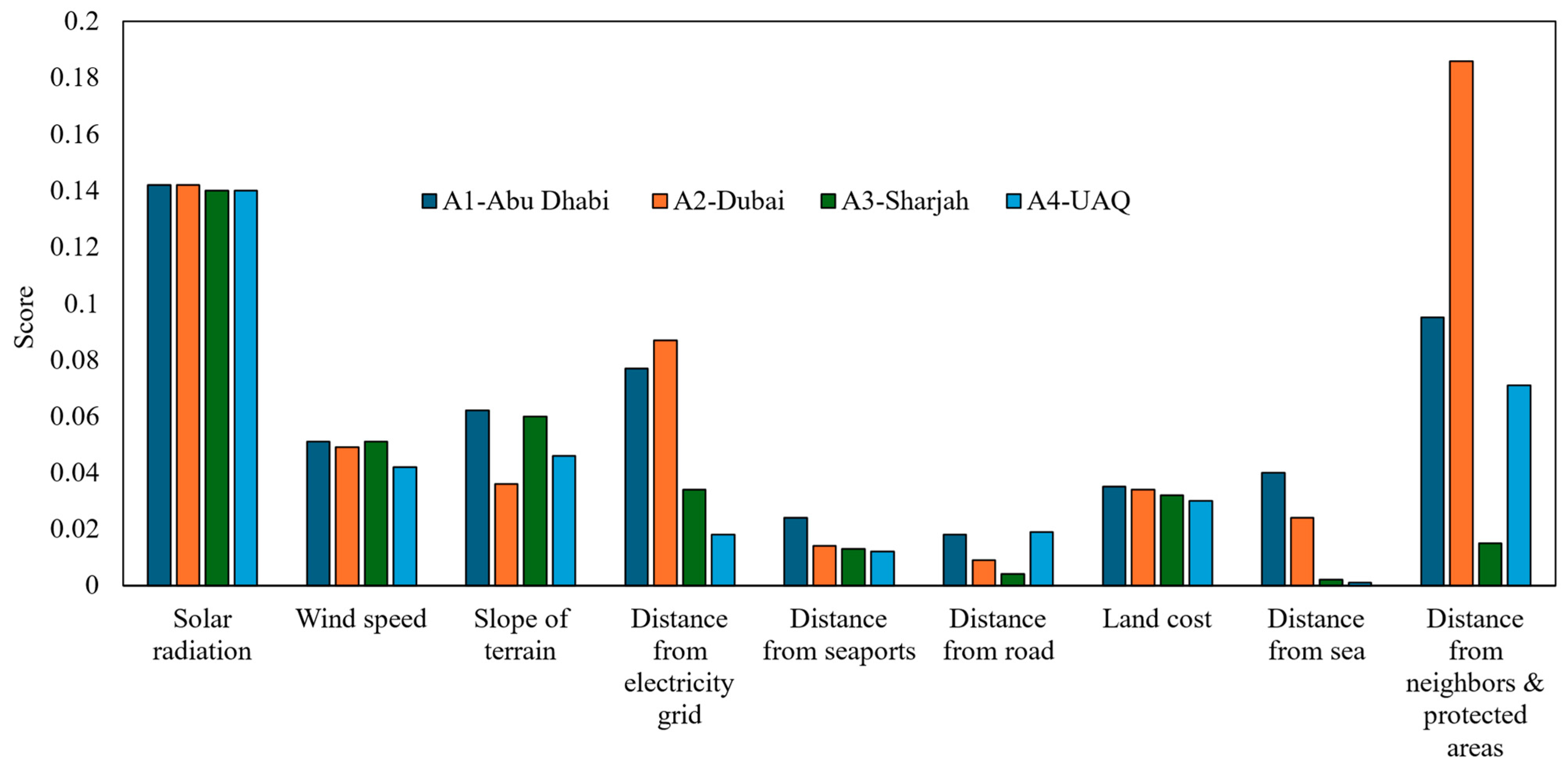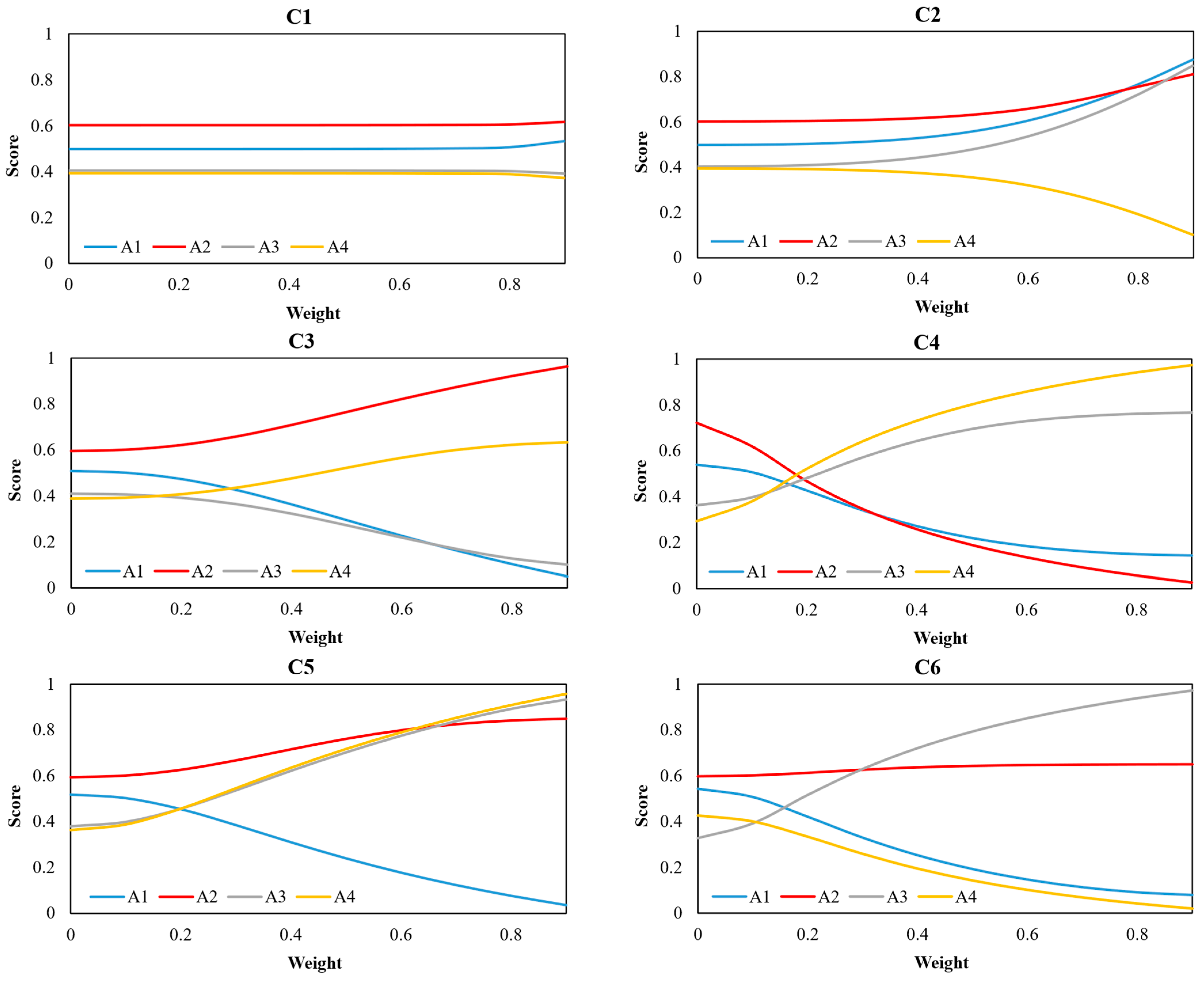Multi-Criteria Decision Making for Selecting the Location of a Solar Photovoltaic Park: A Case Study in UAE
Abstract
:1. Introduction
2. Methodology
2.1. AHP Weighting Model
2.2. TOPSIS
3. Criteria and Alternatives
3.1. Criteria Description
3.2. Alternatives
4. Rankings
5. Conclusions
Author Contributions
Funding
Data Availability Statement
Conflicts of Interest
References
- Aleixandre-Tudó, J.L.; Castelló-Cogollos, L.; Aleixandre, J.L.; Aleixandre-Benavent, R. Renewable energies: Worldwide trends in research, funding and international collaboration. Renew. Energy 2019, 139, 268–278. [Google Scholar] [CrossRef]
- Sharma, V.K.; Singh, R.; Gehlot, A.; Buddhi, D.; Braccio, S.; Priyadarshi, N.; Khan, B. Imperative role of photovoltaic and concentrating solar power technologies towards renewable energy generation. Int. J. Photoenergy 2022, 2022, 3852484. [Google Scholar] [CrossRef]
- Georgiou, A.; Skarlatos, D. Optimal site selection for sitting a solar park using multi-criteria decision analysis and geographical information systems. Geosci. Instrum. Methods Data Syst. 2016, 5, 321–332. [Google Scholar] [CrossRef]
- Shao, M.; Han, Z.; Sun, J.; Xiao, C.; Zhang, S.; Zhao, Y. A review of multi-criteria decision making applications for renewable energy site selection. Renew. Energy 2020, 157, 377–403. [Google Scholar] [CrossRef]
- Silva, L.M.; Ekel, P.; Vieira, D.A.; Libório, M.P.; D’angelo, M.F. Spatial Decision-Making under Uncertainties for Supporting the Prospection of Sites for Hybrid Renewable Energy Generation Systems. Energies 2023, 16, 4880. [Google Scholar] [CrossRef]
- Hosseinzadeh, S.; Etemad-Shahidi, A.; Stewart, R.A. Site Selection of Combined Offshore Wind and Wave Energy Farms: A Systematic Review. Energies 2023, 16, 2074. [Google Scholar] [CrossRef]
- Ghasempour, R.; Nazari, M.A.; Ebrahimi, M.; Ahmadi, M.H.; Hadiyanto, H. Multi-Criteria Decision Making (MCDM) Approach for Selecting Solar Plants Site and Technology: A Review. Int. J. Renew. Energy Dev. 2019, 8, 15–25. [Google Scholar] [CrossRef]
- Ozdemir, S.; Sahin, G. Multi-criteria decision-making in the location selection for a solar PV power plant using AHP. Measurement 2018, 129, 218–226. [Google Scholar] [CrossRef]
- Wang, C.-N.; Nguyen, V.T.; Thai, H.T.; Duong, D.H. Multi-Criteria Decision Making (MCDM) Approaches for Solar Power Plant Location Selection in Viet Nam. Energies 2018, 11, 1504. [Google Scholar] [CrossRef]
- Razeghi, M.; Hajinezhad, A.; Naseri, A.; Noorollahi, Y.; Farhan Moosavian, S. Multi-criteria decision-making for selecting a solar farm location to supply energy to reverse osmosis devices and produce freshwater using GIS in Iran. Sol. Energy 2023, 253, 501–514. [Google Scholar] [CrossRef]
- Hassan, I.; Alhamrouni, I.; Azhan, N.H. A CRITIC–TOPSIS Multi-Criteria Decision-Making Approach for Optimum Site Selection for Solar PV Farm. Energies 2023, 16, 4245. [Google Scholar] [CrossRef]
- Wang, C.-N.; Chung, Y.-C.; Wibowo, F.D.; Dang, T.-T.; Nguyen, N.-A.-T. Site Selection of Solar Power Plants Using Hybrid MCDM Models: A Case Study in Indonesia. Energies 2023, 16, 4042. [Google Scholar] [CrossRef]
- Bao, M.; Arzaghi, E.; Abaei, M.M.; Abbassi, R.; Garaniya, V.; Abdussamie, N.; Heasman, K. Site selection for offshore renewable energy platforms: A multi-criteria decision-making approach. Renew. Energy 2024, 229, 120768. [Google Scholar] [CrossRef]
- Zhang, H.; Zhang, H.; Li, Z.; Xue, Y.; Chang, X.; Su, J.; Wang, P.; Guo, Q.; Sun, H. A Stochastic Bi-level Optimal Allocation Approach of Intelligent Buildings Considering Energy Storage Sharing Services. IEEE Trans. Consum. Electron. 2024, 1–13. [Google Scholar] [CrossRef]
- Lazzari, F.; Mor, G.; Cipriano, J.; Solsona, F.; Chemisana, D.; Guericke, D. Optimizing planning and operation of renewable energy communities with genetic algorithms. Appl. Energy 2023, 338, 120906. [Google Scholar] [CrossRef]
- Bedakhanian, A.; Maleki, A.; Haghighat, S. Utilizing the multi-objective particle swarm optimization for designing a renewable multiple energy system on the basis of the parabolic trough solar collector. Int. J. Hydrogen Energy 2022, 47, 36433–36447. [Google Scholar] [CrossRef]
- Suganthi, L.; Iniyan, S.; Samuel, A.A. Applications of fuzzy logic in renewable energy systems—A review. Renew. Sustain. Energy Rev. 2015, 48, 585–607. [Google Scholar] [CrossRef]
- Ding, B.; Li, Z.; Li, Z.; Xue, Y.; Chang, X.; Su, J.; Sun, H. A CCP-based distributed cooperative operation strategy for multi-agent energy systems integrated with wind, solar, and buildings. Appl. Energy 2024, 365, 123275. [Google Scholar] [CrossRef]
- Donegan, H.A.; Dodd, F.J. A note on saaty’s random indexes. Math. Comput. Model. 1991, 15, 135–137. [Google Scholar] [CrossRef]
- Alzarooni, M.; Olabi, A.G.; Mahmoud, M. Multi-Criteria Decision-Making for Selecting Solar Window Film Sheets for Energy Saving in Buildings. Energies 2024, 17, 3722. [Google Scholar] [CrossRef]
- Chaube, S.; Pant, S.; Kumar, A.; Uniyal, S.; Singh, M.K.; Kotecha, K.; Kumar, A. An Overview of Multi-Criteria Decision Analysis and the Applications of AHP and TOPSIS Methods. Int. J. Math. Eng. Manag. Sci. 2024, 9, 581. [Google Scholar] [CrossRef]
- Almomani, M.A.; Mahafda, Q.M.; Almomani, A.; Bataineh, O. Selecting the best thermal barrier coating material for hot sections in gas turbine using AHP and TOPSIS multi-criteria decision making techniques. Int. J. Interact. Des. Manuf. (IJIDeM) 2024, 1–14. [Google Scholar]
- Atlas, G.S. Validation Report. Available online: https://solargis2-web-assets.s3.eu-west-1.amazonaws.com/public/doc/Validation-Report_Global-Solar-Atlas-2.0_WB-ESMAP_Nov2019-1.pdf (accessed on 14 August 2024).
- SlideModel. Animated United Arab Emirates PowerPoint Map. SlideModel. Available online: https://slidemodel.com/templates/animated-united-arab-emirates-powerpoint-map/ (accessed on 17 July 2024).
- Google. World Map. Google Earth Pro. Available online: https://earth.google.com/web/ (accessed on 22 July 2024).
- SOLARGIS. PVOUT cSi Map. SolarGIS Prospect. Available online: https://apps.solargis.com/ (accessed on 22 July 2024).







| Criteria | Description | |
|---|---|---|
| C1 | Solar radiation (W/m2) | This represents the received power |
| C2 | Wind speed (m/s) | This reduces the PV cell’s temperature |
| C3 | Slope of the terrain (%) | Inclination of the land where the solar park is placed affects the mounting structure type |
| C4 | Distance from the electricity grid (m) | Proximity to the electricity grid |
| C5 | Distance from seaports (m) | Proximity to seaports for the transportation of equipment |
| C6 | Distance from a road (m) | Proximity to the road infrastructure for equipment transportation |
| C7 | Land cost (AED/m2) | Cost of leasing land per year |
| C8 | Distance from the sea | Impact on the corrosivity category of the mounting structure |
| C9 | Distance from neighbors and protected areas (m) | Noise, dust during construction, and visual impact on habitats and species |
| Solar Radiation (GHI) | Description | |
|---|---|---|
| Number of validation sites | 228 | Sites where data can be open to public access |
| Mean bias for all sites | 0.5% | Tendency to overestimate or to underestimate the measured values, on average |
| Standard deviation of biases | ±3.0% | Range of deviation of the model estimates assuming a normal distribution of bias (68% occurrence) |
| Criteria | Abu Dhabi “A1” | Dubai “A2” | Sharjah “A3” | UAQ “A4” | |
|---|---|---|---|---|---|
| C1 | Solar radiation 1 (kWh/m2) | 2201 | 2195 | 2176 | 2170 |
| C2 | Wind speed 2 (m/s) | 3.5 | 3.4 | 3.5 | 2.9 |
| C3 | Slope of the terrain (%) | 2.6% | 1.5% | 2.5% | 1.9% |
| C4 | Distance from the electricity grid (m) | 11,000 | 12,400 | 4800 | 2500 |
| C5 | Distance from seaports (m) | 83,000 | 49,000 | 45,000 | 43,000 |
| C6 | Distance from a road (m) | 470 | 240 | 100 | 500 |
| C7 | Land cost (AED/m2) | 5.25 | 5 | 4.75 | 4.5 |
| C8 | Distance from the sea | 83,000 | 49,000 | 4800 | 2500 |
| C9 | Distance from neighbors and protected areas (m) | 9700 | 19,000 | 1500 | 7200 |
| Method | AHP-TOPSIS | No Priority-TOPSIS | ||
|---|---|---|---|---|
| Alternatives | Score | Rank | Score | Rank |
| A1 | 0.4427 | 2 | 0.4986 | 2 |
| A2 | 0.7108 | 1 | 0.602 | 1 |
| A3 | 0.2432 | 4 | 0.4036 | 3 |
| A4 | 0.4252 | 3 | 0.3934 | 4 |
Disclaimer/Publisher’s Note: The statements, opinions and data contained in all publications are solely those of the individual author(s) and contributor(s) and not of MDPI and/or the editor(s). MDPI and/or the editor(s) disclaim responsibility for any injury to people or property resulting from any ideas, methods, instructions or products referred to in the content. |
© 2024 by the authors. Licensee MDPI, Basel, Switzerland. This article is an open access article distributed under the terms and conditions of the Creative Commons Attribution (CC BY) license (https://creativecommons.org/licenses/by/4.0/).
Share and Cite
Al-Ali, S.; Olabi, A.G.; Mahmoud, M. Multi-Criteria Decision Making for Selecting the Location of a Solar Photovoltaic Park: A Case Study in UAE. Energies 2024, 17, 4235. https://doi.org/10.3390/en17174235
Al-Ali S, Olabi AG, Mahmoud M. Multi-Criteria Decision Making for Selecting the Location of a Solar Photovoltaic Park: A Case Study in UAE. Energies. 2024; 17(17):4235. https://doi.org/10.3390/en17174235
Chicago/Turabian StyleAl-Ali, Saeed, Abdul Ghani Olabi, and Montaser Mahmoud. 2024. "Multi-Criteria Decision Making for Selecting the Location of a Solar Photovoltaic Park: A Case Study in UAE" Energies 17, no. 17: 4235. https://doi.org/10.3390/en17174235
APA StyleAl-Ali, S., Olabi, A. G., & Mahmoud, M. (2024). Multi-Criteria Decision Making for Selecting the Location of a Solar Photovoltaic Park: A Case Study in UAE. Energies, 17(17), 4235. https://doi.org/10.3390/en17174235








